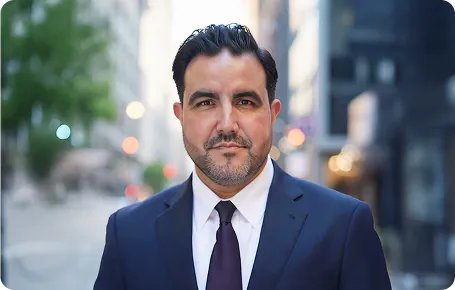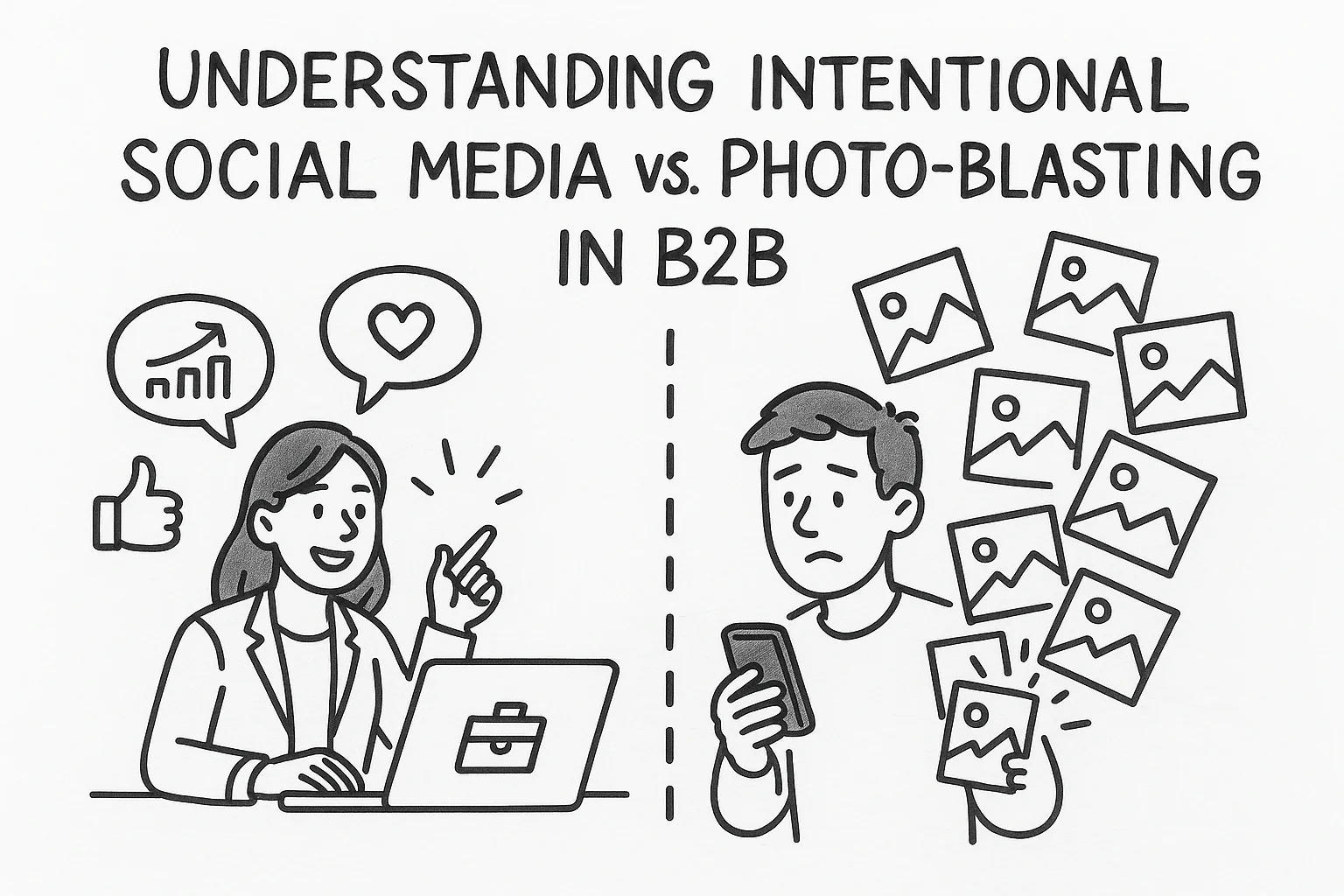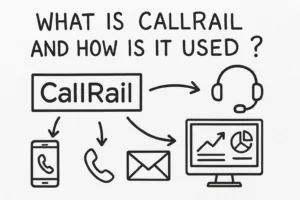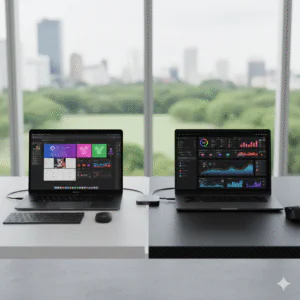What We’ll Cover in This Article: Intentional Social Media vs. Photo-Blasting in B2B
- Why intentional posting beats ego-driven content
- How CEOs and Marketing Directors can guide smarter social strategies
- Best practices for planning purposeful B2B content in 2025
- Which platforms matter most — and exactly how to use them
- Metrics that prove ROI beyond likes
Why This Matters
If you’re a CEO wondering whether social media actually delivers ROI, or a Marketing Director tasked with building a program that sales will respect, this article is for you.
Too many B2B companies confuse “posting often” with “posting well.” They flood feeds with selfies, event shots, or ego-driven posts that might get likes but rarely impact revenue.
Intentional social media is different. Every post has a job: answer a buyer’s question, nurture trust, or point someone back to your website element. Without that clarity, social becomes noise.
What Intentional Social Media Looks Like
Intentional does NOT = boring. It means choosing content that delivers value:
- Answer a real buyer question
- Share a process or lesson learned
- Teach something practical
- Preview insights or data in bite-size form
- Tie into a clear campaign or theme
Contrast: Photo-blast / Ego posts
| Type | Risk | When It’s OK |
|---|---|---|
| “Team having fun at retreat” | Looks irrelevant to buyers | Fine occasionally if tied to brand values or customer outcomes |
| “Look at my award” | Feels self-serving | Better if framed as “3 lessons we learned during the project that earned this recognition” |
| Random memes/quotes | No link to business value | Rare filler only if reinforcing a campaign theme |
A quick test: If your competitor posted the same thing, would your buyer care? If not, skip it.
Best Practices for Intentional B2B Social Media (2025 Edition)
- Start with buyer questions, not content calendars.
- Build posts around the issues prospects care about — not what your team wants to show off.
- Make content snackable.
- Carousels, vertical videos, and LinkedIn documents outperform text-heavy updates.
- Use intent data for targeting.
- When boosting, target accounts already showing purchase intent.
- Integrate paid and organic.
- Post first, then promote winners that align with campaigns.
- Pick platforms strategically.
- Focus only where your buyers spend time.
- Post consistently, not constantly.
- A steady rhythm (3–5 posts per week) beats erratic bursts.
- Empower Advisors and internal experts.
- Their authentic perspectives carry more weight than polished corporate PR.
Doceo Pro Tip: Before posting, ask: Does this solve a problem, or just show off?
The Best Platforms for B2B in 2025 — and How to Use Them
Fresh stat: 85% of B2B marketers say LinkedIn is their most valuable social channel (Taboola – 2025).
LinkedIn → Thought leadership & buyer questions
- Purpose: Establish authority, answer pain points, nurture trust.
- Best formats: Carousels, 1–2 minute video explainers, document posts, or link back to a blog.
- Example: Instead of “We won an award,” post: “Here are 3 lessons we learned during the project that won this award — and how they can help you.” Include a link back to your website.
Instagram → Human, community, and culture
- Purpose: Highlight employees, share behind-the-scenes moments, recap events.
- Why IG, not Facebook: Instagram is more engaged by professionals under 50, has a cleaner interface, and is natural for candid visuals.
- Example: Post a photo from an installation with the caption: “Here’s what goes into moving a 2,000-lb device into place — and why process matters.” Candid and educational.
YouTube → Long-form education
- Purpose: Host explainers, demos, and tutorials. YouTube doubles as a search engine.
- Example: A 2-minute walkthrough: “How secure print release works with PaperCut.” Embed it into your blog, and repurpose clips for LinkedIn.
X (formerly Twitter) → Real-time insights
- Purpose: Add perspective on news and trends.
- Example: During a cyber insurance update, an Advisor posts a thread:
- What the change is.
- Why it matters for SMBs.
- A control to check today.
TikTok / Shorts → Optional reach for younger pros
- Purpose: Use selectively for myth-busting or fast education if your audience skews younger.
- Example: A 30-second “Myth vs Fact”: “Myth: Managed IT is only for large companies. Fact: A 25-employee firm reduced tickets 20% in 60 days with co-managed IT” : IT Solutions overview.
Hypothetical Scenario
Imagine you’re a 150-employee professional services firm:
- LinkedIn: Weekly carousel: “3 billing inefficiencies every CFO should know.”
- Instagram: Team photo from an office move, captioned with what the ops team learned.
- YouTube: 5-minute explainer: “What a hybrid IT onboarding looks like in 60 days.”
- X: Quick thread during tax season: “3 phishing red flags for finance teams.”
This mix feels human, builds authority, and connects back to your site — where leads convert.
Metrics That Matter in B2B Social
Vanity metrics don’t cut it. Measure what ties to pipeline:
- Click-throughs to gated assets
- Form fills and lead conversions
- Pipeline influenced (leads touched by social)
- Engagement from target accounts
- Profile views from buyer personas
Doceo Pro Tip: Repurpose content across formats. A LinkedIn carousel can become a short video script, which can then fuel a blog post.
FAQ
Should B2B brands use Instagram instead of Facebook?
Yes — Instagram has stronger engagement, especially under age 50, and offers a cleaner, more visual-first experience.
How often should we post on LinkedIn?
3–5 posts per week is sustainable for most B2B firms. Consistency > frequency.
Should we try TikTok or Reels?
Only if your buyers are there. Treat them as secondary, not core.
How do we involve employees without chaos?
Provide simple guidelines, templates, and feedback. Amplify their best posts through your main channel.
When should we boost a post?
Boost when a post already performs organically and ties to a campaign theme. Use intent data to target accounts, not the general public.
Wrapping Up
Social media in B2B isn’t about flooding feeds or stroking egos. It’s about intentionality: every post should answer a question, add value, or guide someone back to your site.
When you treat social as part of your buyer’s journey — not a vanity stage — it becomes a compounding asset that supports growth.
👋 Want to audit your social presence or build a buyer-question content plan? Talk to a Doceo Marketing Advisor for clear, pressure-free guidance on what fits your business best.





